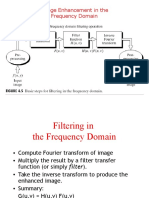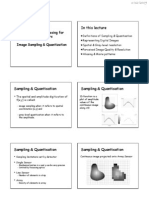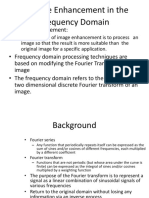0% found this document useful (0 votes)
385 views66 pagesLecture 2-Image Acquisition Image Representation
Digital images are represented as 2D arrays of pixels, each with an intensity value. An image is acquired by sampling and quantizing an analog scene into discrete pixel values. Spatial resolution is determined by sampling rate, while intensity resolution depends on the number of quantization levels. Histograms show the frequency distribution of pixel intensities and can help analyze images for issues like over/under exposure.
Uploaded by
Warnakulasuriya loweCopyright
© © All Rights Reserved
We take content rights seriously. If you suspect this is your content, claim it here.
Available Formats
Download as PDF, TXT or read online on Scribd
0% found this document useful (0 votes)
385 views66 pagesLecture 2-Image Acquisition Image Representation
Digital images are represented as 2D arrays of pixels, each with an intensity value. An image is acquired by sampling and quantizing an analog scene into discrete pixel values. Spatial resolution is determined by sampling rate, while intensity resolution depends on the number of quantization levels. Histograms show the frequency distribution of pixel intensities and can help analyze images for issues like over/under exposure.
Uploaded by
Warnakulasuriya loweCopyright
© © All Rights Reserved
We take content rights seriously. If you suspect this is your content, claim it here.
Available Formats
Download as PDF, TXT or read online on Scribd
/ 66

























































































